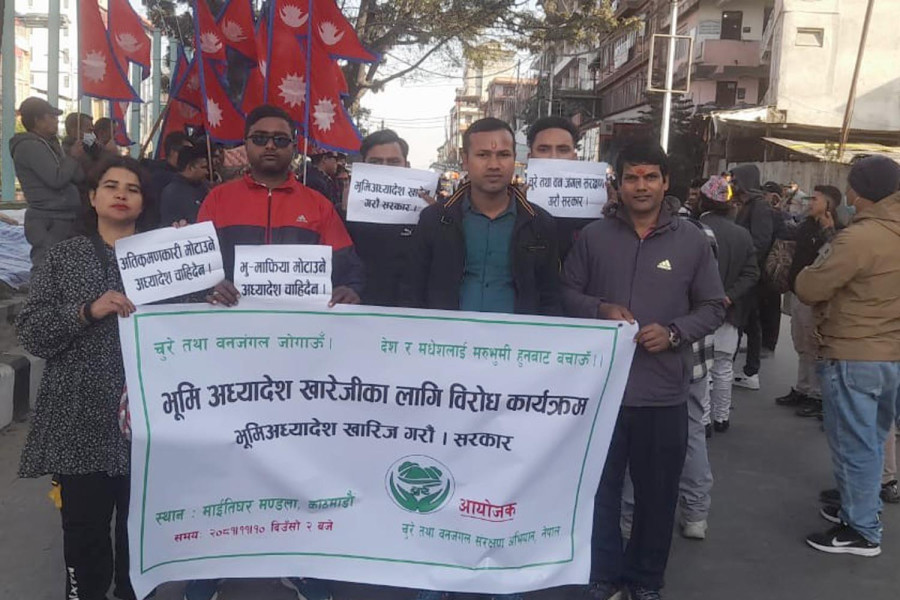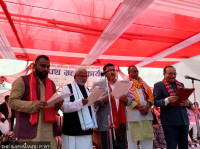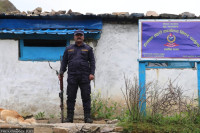National
Chure activists decry land ordinance
They claim it paves the way for encroachment of millions of hectares of Tarai forest land.
Aarati Ray
Activists under the banner of ‘Chure and Forest Conservation Campaign’ staged a demonstration against the government’s land-related ordinance at Maitighar in Kathmandu on Saturday.
Led by Neera Timalsina, Bagmati Province coordinator of the campaign, the activists denounced the ordinance as a blatant attempt to help real estate businesses grab public land in the name of landless individuals, Dalits, and squatters.
Activists claim the ordinance will pave the way for encroachment of millions of hectares of forest land, particularly in the Tarai-Madhesh region.
The land-related ordinance is one of the six that the government issued in December and January.
The controversial ordinance allows the Land Problem Resolution Commission to grant land ownership certificates in forest areas where settlements have existed for the past 15 years and where no significant vegetation remains.
One provision in the ordinance states that if landless Dalits or squatters have been staying in a place that is not covered by trees for the past 15 years, the land can be distributed to the landless people even if that is stated as forest area in government records. This provision has drawn widespread criticism.
“The government is using this ordinance as an electoral strategy to deceive landless people while covertly helping land mafia capture large swathes of forest land,” Timalsina said.
The encroachment of forest land would have adverse effects on the Chure region, forests, and wildlife, and lead to water scarcity in the Tarai-Madhesh settlements, said Sunil Yadav, the founder and coordinator of the Chure and Forest Conservation Campaign.
“We are not against landless individuals, Dalits, and squatters,” he said. “But why is a new ordinance necessary when the existing Land Problem Resolution Commission already has provisions to provide land certificates?”
Meanwhile, Nandakishor Ram Bibsh, a Chure conservation activist, said that the ordinance favours land mafia. “This is a backdoor entry for the land mafia to legalise their encroachment,” he said. “It supports land traders who have been stripping the Chure region of its forests.”
The Janata Samajbadi Party-Nepal (JSP-Nepal) led by Upendra Yadav, which has supported the present government without joining the KP Sharma Oli-led Cabinet, has opposed the land-related ordinance. Mahantha Thakur’s Loktantrik Samajbadi Party (LSP), which is in the Oli Cabinet, has also objected to it.
JSP-Nepal has cautioned that passing the ordinance would “lead to the destruction of the Chure region—the ecological lifeline of Madhesh.”
As a result of the opposition, the government on February 15 had tabled only five of the six ordinances in the National Assembly, shelving the contentious land-related ordinance.
However, parties like JSP and LSP have been calling for revisions to certain provisions before the replacement bills are brought.
Under Nepal’s constitution, ordinances must be approved within 60 days of a House session’s commencement, or they automatically become null and void. The government has until March to take a definitive stance.
Activists say there are several past instances where land has been encroached under the guise of helping squatters.
“Land traders have exploited such loopholes, while genuine landless people continue to suffer,” Sunil Yadav said.
Yadav argued that a cement factory in Siraha district has acquired 2.81 hectares of land through a similar process. “One wealthy individual under the guise of a land squatter got the land ownership certificate of the land and sold it to the Maruti Cement company,” Yadav said.
Another such case is the settlement in Mahendra Highway in Tarai, he added.
According to him, there are many people along the Mahendra Highway in the Tarai region who have got land registration certificates but hardly any of them are real squatters. “They are working with the land mafia while more than 500,000 squatters in Madhesh are still landless,” Yadav added.
The campaigners vow to keep fighting for the protection of Chure forests from encroachment.
“If the government does not repeal the ordinance, we will intensify our protests,” Yadav said. “Our campaign is not just about opposing one ordinance. It is about protecting Nepal’s forests, water sources, and the rights of real landless people.”




 19.12°C Kathmandu
19.12°C Kathmandu













%20(1).jpg&w=300&height=200)

